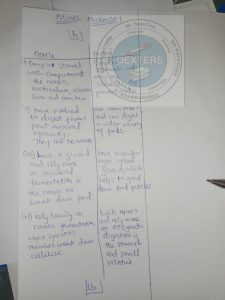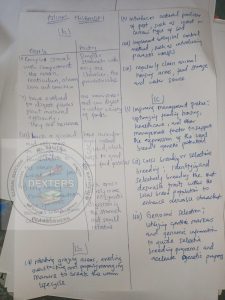Animal Husbandry Waec Answers 2024
(3a)
(i)breed: Breed refers to a specific group of animals that share common characteristics and traits, such as appearance, behavior, and genetic makeup, that distinguish them from other groups within the same species.
(ii)genotype: genotype refers to the genetic makeup of an individual animal, comprising the specific combination of alleles (alternative forms of genes) it inherits from its parents.
(iii) Hybrid: hybrid refers to an individual resulting from the crossbreeding of two different breeds or species within the same genus.
(3b)
(PICK ANY FOUR)
(i)Loss of Genetic Diversity
(ii)Increased Expression of Undesirable Traits
(iii)Decreased Fitness and Vigor
(iv)Inbreeding Depression
(v)Loss of Adaptability
(vi)Reduced Production Efficiency
(3c)
(i)Plant Protein Sources:
(Pick Any Two)
(i)Soybean meal
(ii)Cottonseed meal
(iii)Canola meal
(iv)Pea protein
(ii)Animal Protein Sources:
(Pick Any Two)
(i)Fish meal
(ii)Meat meal (rendered from various animal tissues)
(iii)Blood meal
(iv)Feather meal
(iii)Fiber Sources:
(Pick Any Two)
(i)Alfalfa hay
(ii)Timothy hay
(iii)Corn stalks
(ivWheat straw
(3d)
(Pick Any Four)
(i)Limited Access to Technology
(ii)High Cost of Implementation
(iii)Limited Extension Services
(iv)Cultural and Religious Beliefs
(v)Lack of Awareness and Education
(vi)Preference for Natural Breeding
*NUMBER ONE*
(1a)
(PICK ANY FOUR)
(i) Cattle are ruminants with a complex four-chambered stomach (rumen, reticulum, omasum, abomasum), while poultry have a single-chambered stomach.
(ii) Cattle chew their cud and have the ability to ferment fibrous plant materials in the rumen, while poultry lack this capability.
(iii) Cattle have a longer digestive tract compared to poultry, allowing for more efficient digestion of roughage and cellulose.
(iv) Poultry have a crop and a gizzard, which help grind and store food, while cattle do not have these structures.
(v) Cattle rely more on microbial fermentation in the rumen for nutrient absorption, while poultry have a shorter and more simple digestive system.
(vi) The digestive enzymes and pH levels differ between the two species, with cattle being better adapted to digest fibrous plant materials.
(1b)
(PICK ANY FOUR)
(i) Regularly administering effective anthelmintic (dewormers) to eliminate worms.
(ii) Rotating grazing areas, avoiding overstocking, and properly managing manure to break the worm lifecycle.
(iii) Maintaining clean housing, feeders, and waterers to reduce worm transmission.
(iv) Providing a balanced diet and appropriate nutritional supplements to support the animal’s immune response.
(v) Introducing natural predators of worms, such as certain nematophagous fungi, to reduce worm populations.
(vi) Selecting animals with genetic resistance or tolerance to worm infections to gradually improve the herd’s or flock’s resilience.
(1c)
(PICK ANY THREE)
(i) Crossbreeding: Introducing genetic material from high-performing exotic breeds to improve the productivity and adaptability of local breeds.
(ii) Selective breeding: Identifying and selectively breeding the most desirable traits within the local breed population to enhance desirable characteristics.
(iii) Genomic selection: Utilizing genetic markers and genomic information to guide selective breeding programs and accelerate genetic progress.
(iv)Improving management practices: Optimizing feeding, housing, healthcare, and other management factors to support the expression of the local breed’s genetic potential.
(1d)
(i) CREEP FEEDING
(PICK ANY THREE)
(i) Increased growth rate and weight gain in young animals
(ii) Improved feed conversion efficiency
(iii) Enhanced immune function and disease resistance
(iv) Earlier weaning and transition to solid feed
(ii) DEHORNING
(PICK ANY THREE)
(i) Reduces the risk of injuries to animals and handlers
(ii) Prevents damage to housing, equipment, and other animals
(iii) Facilitates easier handling and management of the animals
(iv) Helps maintain a more uniform herd or flock appearance
(5a)
(i) Improved growth rates and feed conversion efficiency.
(ii) Enhanced immune function, leading to reduced disease incidence.
(iii) Better nutrient absorption and utilization.
(iv) Increased egg production and quality.
(v) Enhanced meat quality and flavor.
(5b)
(i) Facilitating distribution to diverse markets.
(ii) Providing storage facilities to maintain egg quality.
(iii) Offering transportation services to reach distant markets.
(iv) Assisting in price negotiation between producers and retailers.
(v) Absorbing market risks by buying and selling eggs at stable prices.
(5c)
(i) Anthrax: Bacillus anthracis (affects cattle, sheep, and goats)
(ii) Coccidiosis: Various species of the protozoan parasite Eimeria (affects poultry)
(iii) Aspergillosis: Aspergillus spp. fungi (affects birds, particularly poultry)
(5d)
(i) Genetic differences.
(ii) Environmental factors, such as nutrition and temperature.
(iii) Hormonal regulation.
(iv) Social factors, including dominance hierarchy and social interactions.
(2a)
(i) Improved animal health and welfare.
(ii) Better control of environmental factors like temperature and humidity.
(iii) Reduced risk of disease transmission.
(iv) Increased productivity and growth rates.
(v) Enhanced reproductive performance.
(vi) Minimized stress levels leading to higher quality products.
(2b)
(i) Preventing aggression and injury among different age groups.
(ii) Avoiding competition for resources such as food and water.
(iii) Minimizing the spread of diseases between age groups.
(iv) Tailoring feeding and management practices to specific age-related needs.
(2c)
(i) Cleaning and disinfecting the entire facility.
(ii) Checking and calibrating heating equipment to maintain appropriate temperature levels.
(iii) Providing clean bedding material.
(iv) Ensuring adequate ventilation.
(v) Setting up feeders and drinkers with fresh water and appropriate chick feed.
(2d)
(i) Pelt: Sheep
(ii) Bristle: Pig
(iii) Mohair: Angora goat
(iv) Veal: Calf (young cattle)
(v) Lard: Pig

(2a)
(Pick Aby SIX)
(i) Protection from adverse weather conditions like extreme temperatures, rain, and wind.
(ii) Prevention of predation by providing a secure environment.
(iii) Reduction of stress, which can improve overall health and productivity.
(iv) Control of disease transmission through proper sanitation and biosecurity measures.
(v) Facilitation of efficient management practices such as feeding, watering, and healthcare.
(vi) Optimization of growth rates and production through controlled environments.
(vii) Enhancement of reproductive performance and breeding success.
(viii) Minimization of injuries and accidents, leading to healthier and more profitable animals
(2b)
(Pick Any FOUR)
(i) Prevention of aggressive behavior and competition for resources among different age groups.
(ii) Reduction of the risk of injury, particularly to younger or smaller goats, from dominant individuals.
(iii) Facilitation of age-specific feeding and nutritional requirements to support growth and development.
(iv) Control of disease transmission between age groups, as susceptibility to certain diseases may vary with age.
(v) Optimization of management practices such as deworming, vaccination, and health monitoring tailored to specific age groups.
(vii) Promotion of better socialization and behavioral development by allowing goats to interact with peers of similar age and size.
(2c)
(Pick Any FIVE)
(i) Cleaning and disinfection of the brooder house to remove any potential pathogens and provide a clean environment for the chicks.
(ii) Installation and testing of heating equipment to maintain appropriate temperature levels for the chicks.
(iii) Placement of clean and dry bedding material such as wood shavings or straw to provide a comfortable resting area.
(iv) Provision of clean feeders and drinkers filled with fresh water and appropriate chick feed.
(v) Adjustment of lighting to simulate natural day-night cycles and promote healthy growth and development.
(vi) Checking for any potential hazards or safety risks in the brooder house and addressing them accordingly.
(vii) Preparation of necessary equipment and supplies for monitoring chick health and welfare, such as thermometers, brooder guards, and first aid kits.
(2d)
(i) Pelt – Chicken
(ii) Bristle – Pig
(iii) Mohair – Goat
(iv) Veal – Calf
(v) Lard – Pig

(2a)
(Pick Aby SIX)
(i) Protection from adverse weather conditions like extreme temperatures, rain, and wind.
(ii) Prevention of predation by providing a secure environment.
(iii) Reduction of stress, which can improve overall health and productivity.
(iv) Control of disease transmission through proper sanitation and biosecurity measures.
(v) Facilitation of efficient management practices such as feeding, watering, and healthcare.
(vi) Optimization of growth rates and production through controlled environments.
(vii) Enhancement of reproductive performance and breeding success.
(viii) Minimization of injuries and accidents, leading to healthier and more profitable animals
(2b)
(Pick Any FOUR)
(i) Prevention of aggressive behavior and competition for resources among different age groups.
(ii) Reduction of the risk of injury, particularly to younger or smaller goats, from dominant individuals.
(iii) Facilitation of age-specific feeding and nutritional requirements to support growth and development.
(iv) Control of disease transmission between age groups, as susceptibility to certain diseases may vary with age.
(v) Optimization of management practices such as deworming, vaccination, and health monitoring tailored to specific age groups.
(vii) Promotion of better socialization and behavioral development by allowing goats to interact with peers of similar age and size.
(2c)
(Pick Any FIVE)
(i) Cleaning and disinfection of the brooder house to remove any potential pathogens and provide a clean environment for the chicks.
(ii) Installation and testing of heating equipment to maintain appropriate temperature levels for the chicks.
(iii) Placement of clean and dry bedding material such as wood shavings or straw to provide a comfortable resting area.
(iv) Provision of clean feeders and drinkers filled with fresh water and appropriate chick feed.
(v) Adjustment of lighting to simulate natural day-night cycles and promote healthy growth and development.
(vi) Checking for any potential hazards or safety risks in the brooder house and addressing them accordingly.
(vii) Preparation of necessary equipment and supplies for monitoring chick health and welfare, such as thermometers, brooder guards, and first aid kits.
(2d)
(i) Pelt – Chicken
(ii) Bristle – Pig
(iii) Mohair – Goat
(iv) Veal – Calf
(v) Lard – Pig
(1a)
(PICK ANY FOUR)
(i) Cattle are ruminants with a complex four-chambered stomach (rumen, reticulum, omasum, abomasum), while poultry have a single-chambered stomach.
(ii) Cattle chew their cud and have the ability to ferment fibrous plant materials in the rumen, while poultry lack this capability.
(iii) Cattle have a longer digestive tract compared to poultry, allowing for more efficient digestion of roughage and cellulose.
(iv) Poultry have a crop and a gizzard, which help grind and store food, while cattle do not have these structures.
(v) Cattle rely more on microbial fermentation in the rumen for nutrient absorption, while poultry have a shorter and more simple digestive system.
(vi) The digestive enzymes and pH levels differ between the two species, with cattle being better adapted to digest fibrous plant materials.
(1b)
(PICK ANY FOUR)
(i) Regularly administering effective anthelmintic (dewormers) to eliminate worms.
(ii) Rotating grazing areas, avoiding overstocking, and properly managing manure to break the worm lifecycle.
(iii) Maintaining clean housing, feeders, and waterers to reduce worm transmission.
(iv) Providing a balanced diet and appropriate nutritional supplements to support the animal’s immune response.
(v) Introducing natural predators of worms, such as certain nematophagous fungi, to reduce worm populations.
(vi) Selecting animals with genetic resistance or tolerance to worm infections to gradually improve the herd’s or flock’s resilience.
(1c)
(PICK ANY THREE)
(i) Crossbreeding: Introducing genetic material from high-performing exotic breeds to improve the productivity and adaptability of local breeds.
(ii) Selective breeding: Identifying and selectively breeding the most desirable traits within the local breed population to enhance desirable characteristics.
(iii) Genomic selection: Utilizing genetic markers and genomic information to guide selective breeding programs and accelerate genetic progress.
(iv)Improving management practices: Optimizing feeding, housing, healthcare, and other management factors to support the expression of the local breed’s genetic potential.
(1d)
(i) CREEP FEEDING
(PICK ANY THREE)
(i) Increased growth rate and weight gain in young animals
(ii) Improved feed conversion efficiency
(iii) Enhanced immune function and disease resistance
(iv) Earlier weaning and transition to solid feed
(ii) DEHORNING
(PICK ANY THREE)
(i) Reduces the risk of injuries to animals and handlers
(ii) Prevents damage to housing, equipment, and other animals
(iii) Facilitates easier handling and management of the animals
(iv) Helps maintain a more uniform herd or flock appearance
=========
(2a)
(Pick Aby SIX)
(i) Protection from adverse weather conditions like extreme temperatures, rain, and wind.
(ii) Prevention of predation by providing a secure environment.
(iii) Reduction of stress, which can improve overall health and productivity.
(iv) Control of disease transmission through proper sanitation and biosecurity measures.
(v) Facilitation of efficient management practices such as feeding, watering, and healthcare.
(vi) Optimization of growth rates and production through controlled environments.
(vii) Enhancement of reproductive performance and breeding success.
(viii) Minimization of injuries and accidents, leading to healthier and more profitable animals
(2b)
(Pick Any FOUR)
(i) Prevention of aggressive behavior and competition for resources among different age groups.
(ii) Reduction of the risk of injury, particularly to younger or smaller goats, from dominant individuals.
(iii) Facilitation of age-specific feeding and nutritional requirements to support growth and development.
(iv) Control of disease transmission between age groups, as susceptibility to certain diseases may vary with age.
(v) Optimization of management practices such as deworming, vaccination, and health monitoring tailored to specific age groups.
(vii) Promotion of better socialization and behavioral development by allowing goats to interact with peers of similar age and size.
(2c)
(Pick Any FIVE)
(i) Cleaning and disinfection of the brooder house to remove any potential pathogens and provide a clean environment for the chicks.
(ii) Installation and testing of heating equipment to maintain appropriate temperature levels for the chicks.
(iii) Placement of clean and dry bedding material such as wood shavings or straw to provide a comfortable resting area.
(iv) Provision of clean feeders and drinkers filled with fresh water and appropriate chick feed.
(v) Adjustment of lighting to simulate natural day-night cycles and promote healthy growth and development.
(vi) Checking for any potential hazards or safety risks in the brooder house and addressing them accordingly.
(vii) Preparation of necessary equipment and supplies for monitoring chick health and welfare, such as thermometers, brooder guards, and first aid kits.
(2d)
(i) Pelt – Chicken
(ii) Bristle – Pig
(iii) Mohair – Goat
(iv) Veal – Calf
(v) Lard – Pig
(vi) Checking for any potential hazards or safety risks in the brooder house and addressing them accordingly.
(vii) Preparation of necessary equipment and supplies for monitoring chick health and welfare, such as thermometers, brooder guards, and first aid kits.
(2d)
(i) Pelt – Chicken
(ii) Bristle – Pig
(iii) Mohair – Goat
(iv) Veal – Calf
(v) Lard – Pig
(5a)
(i) Improved growth rates and feed conversion efficiency.
(ii) Enhanced immune function, leading to reduced disease incidence.
(iii) Better nutrient absorption and utilization.
(iv) Increased egg production and quality.
(v) Enhanced meat quality and flavor.
(5b)
(i) Facilitating distribution to diverse markets.
(ii) Providing storage facilities to maintain egg quality.
(iii) Offering transportation services to reach distant markets.
(iv) Assisting in price negotiation between producers and retailers.
(v) Absorbing market risks by buying and selling eggs at stable prices.
(5c)
(i) Anthrax: Bacillus anthracis (affects cattle, sheep, and goats)
(ii) Coccidiosis: Various species of the protozoan parasite Eimeria (affects poultry)
(iii) Aspergillosis: Aspergillus spp. fungi (affects birds, particularly poultry)
(5d)
(i) Genetic differences.
(ii) Environmental factors, such as nutrition and temperature.
(iii) Hormonal regulation.
(iv) Social factors, including dominance hierarchy and social interactions.
(6ai)
physiological status: Physiological status of farm animals, such as whether they are pregnant, lactating, growing, or in maintenance, significantly influences their nutrient requirements.
(6aii)
Age: Age directly impacts the nutrient requirements and digestive capacity of farm animals. Young animals have higher nutrient needs for growth and development compared to mature animals
(6aiii)
Nutrient composition of feedstuff: Formulating feeds based on the nutrient composition of feedstuff ensures that animals receive balanced diets that meet their specific nutrient requirements.
(6b)
(PICK ANY FIVE)
(i)process of slaughtering
(ii) undergoes dressing
(iii)Cutting and Boning
(iv)transforming raw meat into value-added products
(v)Packaging using appropriate materials
(vi)Storage and Distribution
(6c)
(i)selection: selection refers to the process of choosing animals with desirable traits for breeding purposes, with the goal of improving the overall genetic quality of the herd or flock.
(ii)Pasture: Pasture is an area of land covered with grasses, legumes, or other forage crops that is utilized for grazing by livestock.
(iii)Artificial Insemination: Artificial insemination (AI) is a reproductive technology used in animal production to breed livestock without natural mating
(6d)
(PICK ANY THREE)
(i)meat
(ii)Pelts
(iii)Manure
(iv)Pets
ANIMAL OBJECTIVE
1CCBCDBACCC
11AACCDACCAA
21ABBBAACCBA
31BCCCDABBAB
Completed!!

